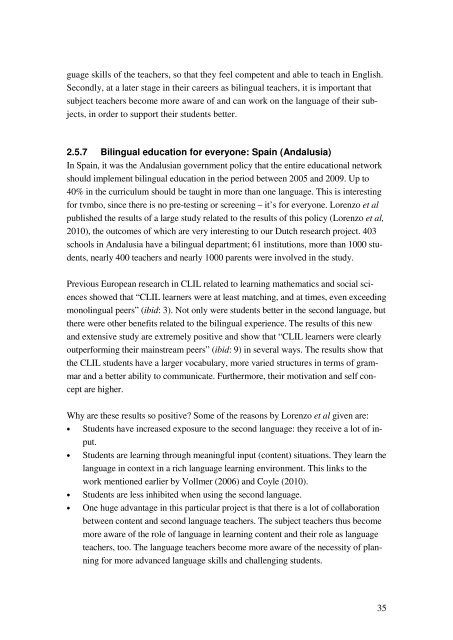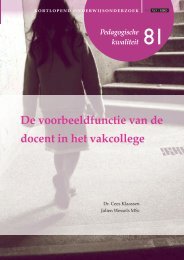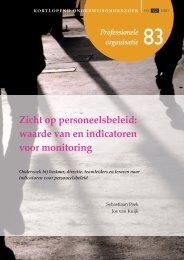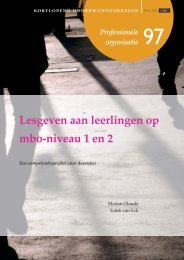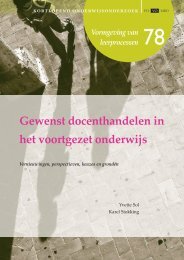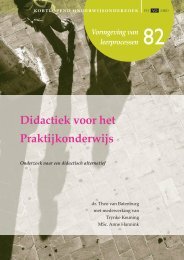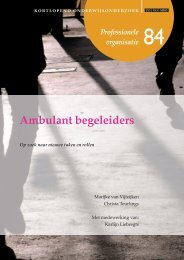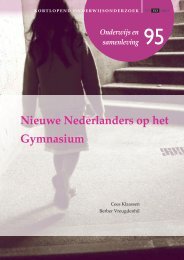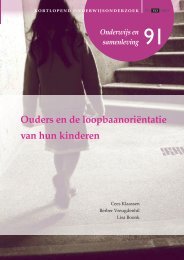Proud to be tvmbo - Kortlopend Onderwijsonderzoek
Proud to be tvmbo - Kortlopend Onderwijsonderzoek
Proud to be tvmbo - Kortlopend Onderwijsonderzoek
Create successful ePaper yourself
Turn your PDF publications into a flip-book with our unique Google optimized e-Paper software.
guage skills of the teachers, so that they feel competent and able <strong>to</strong> teach in English.<br />
Secondly, at a later stage in their careers as bilingual teachers, it is important that<br />
subject teachers <strong>be</strong>come more aware of and can work on the language of their subjects,<br />
in order <strong>to</strong> support their students <strong>be</strong>tter.<br />
2.5.7 Bilingual education for everyone: Spain (Andalusia)<br />
In Spain, it was the Andalusian government policy that the entire educational network<br />
should implement bilingual education in the period <strong>be</strong>tween 2005 and 2009. Up <strong>to</strong><br />
40% in the curriculum should <strong>be</strong> taught in more than one language. This is interesting<br />
for <strong>tvmbo</strong>, since there is no pre-testing or screening – it’s for everyone. Lorenzo et al<br />
published the results of a large study related <strong>to</strong> the results of this policy (Lorenzo et al,<br />
2010), the outcomes of which are very interesting <strong>to</strong> our Dutch research project. 403<br />
schools in Andalusia have a bilingual department; 61 institutions, more than 1000 students,<br />
nearly 400 teachers and nearly 1000 parents were involved in the study.<br />
Previous European research in CLIL related <strong>to</strong> learning mathematics and social sciences<br />
showed that “CLIL learners were at least matching, and at times, even exceeding<br />
monolingual peers” (ibid: 3). Not only were students <strong>be</strong>tter in the second language, but<br />
there were other <strong>be</strong>nefits related <strong>to</strong> the bilingual experience. The results of this new<br />
and extensive study are extremely positive and show that “CLIL learners were clearly<br />
outperforming their mainstream peers” (ibid: 9) in several ways. The results show that<br />
the CLIL students have a larger vocabulary, more varied structures in terms of grammar<br />
and a <strong>be</strong>tter ability <strong>to</strong> communicate. Furthermore, their motivation and self concept<br />
are higher.<br />
Why are these results so positive? Some of the reasons by Lorenzo et al given are:<br />
• Students have increased exposure <strong>to</strong> the second language: they receive a lot of input.<br />
• Students are learning through meaningful input (content) situations. They learn the<br />
language in context in a rich language learning environment. This links <strong>to</strong> the<br />
work mentioned earlier by Vollmer (2006) and Coyle (2010).<br />
• Students are less inhibited when using the second language.<br />
• One huge advantage in this particular project is that there is a lot of collaboration<br />
<strong>be</strong>tween content and second language teachers. The subject teachers thus <strong>be</strong>come<br />
more aware of the role of language in learning content and their role as language<br />
teachers, <strong>to</strong>o. The language teachers <strong>be</strong>come more aware of the necessity of planning<br />
for more advanced language skills and challenging students.<br />
35


